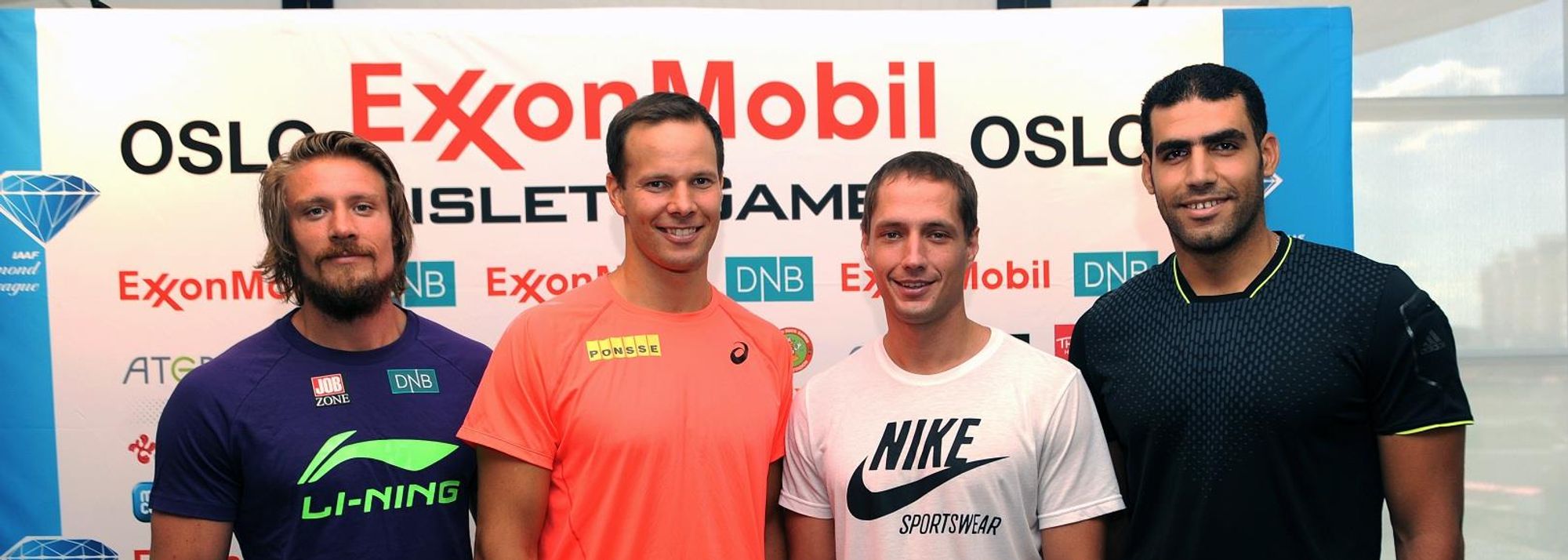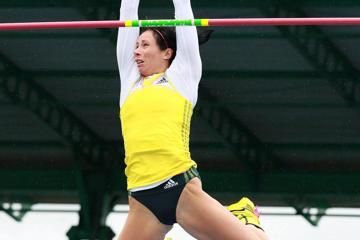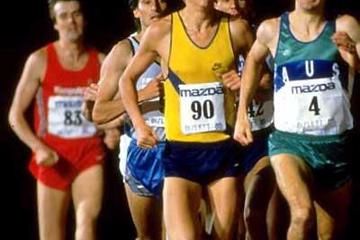Andreas Thokildsen, Tero Pitkamaki, Vítezslav Vesely & Ihab Abdelrahman El Sayed at the 2014 IAAF Diamond League press conference in Oslo (© Mark Shearman)
There were three main topics of conversation at the ‘javelin special’ press conference ahead of the ExxonMobil Bislett Games IAAF Diamond League meeting in Oslo on Wednesday (11) – injuries, upsets to javelin’s world order, and Tero Pitkamaki’s baby boy, who was born yesterday.
Let’s take the new arrival first.
Weighing in at 3.99kg and 55cm, the former World champion’s son is “already a big boy”, according to his dad, who described himself as, “super happy and super tired”.
“I haven’t slept in three nights, but everything is ok. He’s healthy, his mum’s healthy, so I’m happy,” said Pitkamaki, who politely declined to reveal the one-day old’s new name to a room full of athletics journalists.
“Maybe I know it,” he laughed. “But I’m not going to tell you.”
At which point attention turned to another new arrival, 25-year-old Ihab Abdelrahman El Sayed, the new kid on the block who shot to the top of the javelin world lists with a phenomenal African record of 89.21m at the IAAF Diamond League meeting in Shanghai last month.
His throw, in the first round, not only improved his own Egyptian record by nearly six metres, and put him four metres clear of the rest of the world in 2014, but was also the longest throw in the world for nearly seven years and catapulted the genial, quietly-spoken giant into 13th place on the world all-time list.
Oddly, for an event that’s so often dominated by Czechs and Scandiavians, Abdelrahman is joined in this year’s current world top 10 by a Japanese, a Slovakian, a Pole, a Swede, an American and a Trinidadian.
So what’s going on?
Not much, according to Abdelrahman.
Coach clairvoyant
“I wasn’t surprised, really,” he said, when asked if he was as shocked as the rest of world’s javelin watchers by his out-of-the-sky effort. “My coach told me I would throw over 87. I didn’t believe him. I thought I could do 85, maybe, but it happened as he said it would.”
His coach is Petteri Piironen, the Finn who guided Kenya’s Julius Yego to fourth place at the 2013 IAAF World Championships last year.
Abdelrahman has been visiting Piironen in Kuortane since 2008, the year he won an IAAF World Junior Championships silver medal, but only for a few weeks at a time, until this winter when he spent four months in the bitter Scandinavian cold, a hardship that has clearly paid off.
“Before this year, I basically trained alone in Egypt, without a coach,” he said, when asked to explain his sudden improvement. “But this year I spent more time with my coach in Finland and he corrected some things in my technique.
“I threw 83 without a coach last year; now I’ve reached 89. He’s a beautiful coach.”
Abdelrahman followed up his mammoth opening effort in Shanghai with another long throw of 86.01m in round two, but then twisted his ankle and passed his last three attempts. The niggling injury meant he was well below par three days later in Beijing, when he could manage only 74.03m.
So how far does he think he will throw tomorrow?
“Ninety metres, I hope,” said Abdelrahman. “Inshallah.
“I think I can throw well, especially with these guys in the field. I watched them all the time on You Tube. They’ve been my inspiration.”
By “these guys” he meant, not just Pitkamaki, the Moscow 2013 silver medallist, but Czech Republic’s Vítezslav Vesely, the current world and European champion, and Norway’s own athletics darling, Andreas Thorkildsen, the two-times Olympic and former world champion who threw his own personal best of 91.59m at the Bislett Games in 2006.
El Sayed now merits serious consideration
So were they surprised by Abdelrahman’s advance? “I’ll probably take him more seriously as a competitor now,” admitted the laid-back Thorkildsen, now sporting an unfamiliar beard.
“He’s been coming through the ranks for a while. I was a bit surprised with 89, but he’s a big guy so he can throw far.”
“It was a big surprise,” agreed Pitkamaki, who sometimes trains in the same Kuortane venue as the Egyptian. “I knew he could throw over 85 because I’ve seen him do it in training, but it was a surprise what he did in Shanghai. Now I need to improve my throwing to compete with him.”
No longer the inspired newcomer, Abdelrahman is now a source of inspiration, even for these seasoned multiple medal-winners.
“It was good for javelin,” said Vesely. “When I saw Ihab’s throw in Shanghai I thought if he can do it, it’s still possible for me to do that in my career too, that I still have room for improvement.
“It makes the event more attractive too. Perhaps now we can all compete at a higher level again.”
After taking the European title in 2012, Vesely produced his best of 88.34m in the qualifying round at the London 2012 Olympic Games, but then finished out of the medals in fourth place.
He made amends by winning the World title in 2013, but has been forced to treat this season as a “take it slowly” year after suffering a knee injury during winter training which left him unable to run properly for weeks, and still causes “little problems” with his run-up.
“In February I couldn’t even run 100m easily,” he said. “The muscle around my knee was like a baby’s muscle because I missed so much training.
“Now it is better than I expected, so I’m hoping for some good results, starting tomorrow. I still think I can throw well, but the priority this year is to take care of my legs. The next two years are really important, so this season everything will depend on my knee.”
Tero’s new targets
Pitkamaki is also emerging from injury problems, in his case an elbow operation on 1 April which has restricted his range so far.
The Finn was a modest sixth in Shanghai with 81.38m but improved to 83.93m on home soil in Lappeenranta last week.
“I haven’t done so much throwing since the operation,” he said. “But I think it’s getting better and better, and I’m hoping for good results from Oslo onwards.”
As for his main goal for the season, “Well, that came yesterday,” he said, before adding, “But in the javelin, it’s the European Championships in Zurich and a 90-metre throw.”
Thorkildsen, meanwhile, insists his years of ankle, knee and elbow injuries are all behind him.
“I’m healthy,” he said. “It’s all good.”
His one competition so far this year came at the Prefontaine Classic in Eugene, another IAAF Diamond League meeting, where difficult conditions meant his mediocre best of 80.52m was good enough for second.
“I was happy to get the first one done with,” said the 32-year-old. “I have a little higher expectations for tomorrow when I will be a lot more comfortable on the runway.”
As for the new world order, the ever-confident Thorkildsen hinted that normal service may well be resumed shortly.
“Can I throw 89 metres? Yes. I can’t promise I will do it, but I’m able to.”
“It’s still early season” he added. “It’s interesting to have new countries coming in and mixing up the list, but it will also be interesting to see where we’re all at after a few more competitions.”
The remixing starts on Wednesday, minus the London 2012 Olympic Games champion Keshorn Walcott, who was a late withdrawal due to an elbow injury.
Matthew Brown for the IAAF











